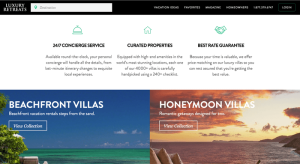Key Features Every Tourism Website Should Have for an Unforgettable User Experience
A well-designed and user-friendly tourism website is essential in today’s digital age for drawing tourists and highlighting a destination’s distinctive features. Tourism websites must go above and beyond to deliver a seamless and engaging experience as more and more people use the internet to plan their holidays. Here are the key components that every tourism website should include to leave a lasting impression, from eye-catching visuals to educational material and interactive technologies.
1. Captivating Visuals That Transport Visitors
A picture really does speak a thousand words, and this is especially true for travel websites. A destination’s first impression is created through attractive, high-quality images, which entice potential visitors to learn more. Make use of eye-catching photos and films that emphasize the area’s scenic features, cultural landmarks, and distinctive experiences. Use responsive design to make sure that these graphics look amazing on all types of platforms, including desktop computers and mobile phones.

2. User-Friendly Navigation for Seamless Exploration
When it comes to tourism websites, user experience is key. Implement user-friendly navigation to make it simple for visitors to find the data they require. Create menus that are simple and concise, properly classify the material, and offer a powerful search tool. Include breadcrumb navigation as well to aid users in understanding their position within the site’s hierarchy. An intuitive user design encourages longer visits and lessens annoyance, which increases the possibility of turning site visitors into actual tourists.
3. Comprehensive Destination Information
A tourist website’s main goal is to inform and educate potential visitors about the location. Information about local events, accommodations, food options, and attractions should be complete and up to date. Content should be divided into categories like “Things to Do,” “Where to Stay,” “Dining Experiences,” and “Events Calendar.” Make certain that each bit of information is true, interesting, and aids visitors in visualizing their impending journey. https://diversewebsitedesign.com.au/
4. Personalized Trip Planning Tools
Offering individualized trip planning options can significantly improve a visitor’s website experience. Create interactive tools that let users alter their trip plans in accordance with their interests, schedules, and preferences. Offer options for saving and sharing these routes, and incorporate maps for simple navigation. You may boost user engagement and position your website as a useful travel resource by assisting users with trip planning directly on the website.
5. Authentic User Reviews and Testimonials
In the travel sector, establishing trust is essential. Include truthful user testimonials and reviews to highlight previous visitors’ impressions. Include a section just for reviews so that visitors may offer their opinions on the lodgings, attractions, and overall experience. Potential customers are more likely to book a trip after reading positive evaluations, while prospective customers are more likely to do so after reading constructive criticism.
6. Multi-Lingual Support for Global Reach
Your website should reflect that tourism has no geographical restrictions. Implement multilingual assistance to serve a wide range of international tourists. Offer material in several languages and make sure non-English speakers can access navigational elements and crucial information. This inclusive strategy not only widens your audience, but it also conveys a friendly disposition toward tourists from other countries.
7. Integration with Social Media Platforms
Travel experiences now include social media in spades. Include share buttons, embedded feeds, and links to the official social media profiles of your location to integrate social media. This increases the reach of your website and fosters a feeling of community among travelers by enabling users to quickly share their favorite information and experiences with their networks.
8. Timely and Relevant Content Updates
Regularly add new and pertinent information to your website to keep visitors interested and informed. Keep a blog that discusses local knowledge, travel advice, and forthcoming events. Tell tales about the background, culture, and distinctive characteristics of the place. You can establish your website as a go-to resource for both potential and returning visitors by offering useful and current material. https://www.dynamicwebdesign.com.au/website-design-sunshine/

9. Mobile-Friendly Responsiveness
Making sure your website is mobile-friendly is now essential given the popularity of mobile devices. Utilize responsive design methods to make your website mobile-friendly. This makes sure that your content displays and works properly on devices with different screen sizes and orientations, giving all visitors a consistent and satisfying experience.
10. Clear Calls to Action for Conversion
A great tourist website should ultimately compel users to take action, whether it be reserving lodging, signing up for newsletters, or looking into travel deals. Use calls to action (CTAs) that are distinct and appealing and are placed thoughtfully throughout the website. Use eye-catching buttons, succinct content, and alluring graphics to direct people to conversion points. An effective CTA can distinguish between a casual traveler and a devoted one.
Conclusion
In the digital age, a destination’s tourist website frequently serves as the first point of contact with potential visitors. You can develop a memorable user experience that arouses wanderlust and boosts conversions by incorporating captivating visuals, easy-to-use navigation, thorough information, personalized trip planning tools, authentic reviews, multilingual support, social media integration, timely content updates, mobile friendliness, and potent calls to action. A well-designed travel website does more than just advertise a place; it takes users on a virtual journey that has a lasting impression, guaranteeing that their actual travel experience will be nothing short of exceptional.






